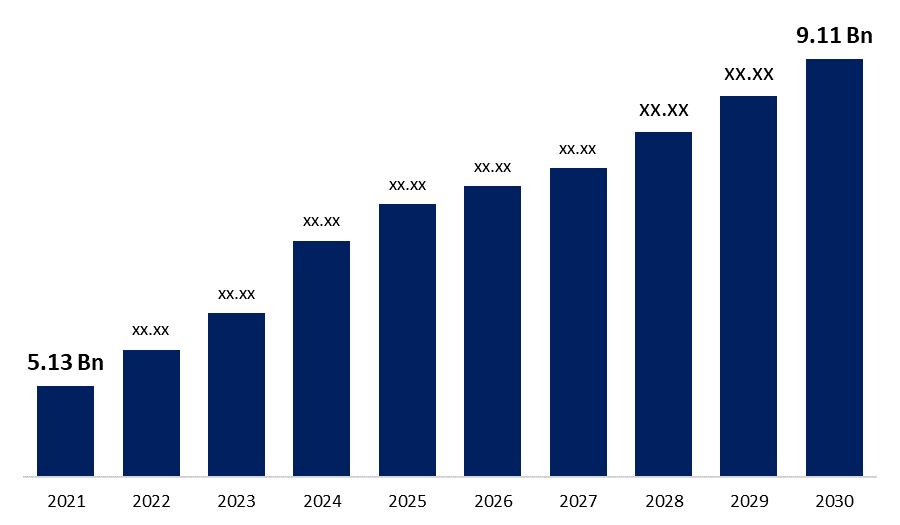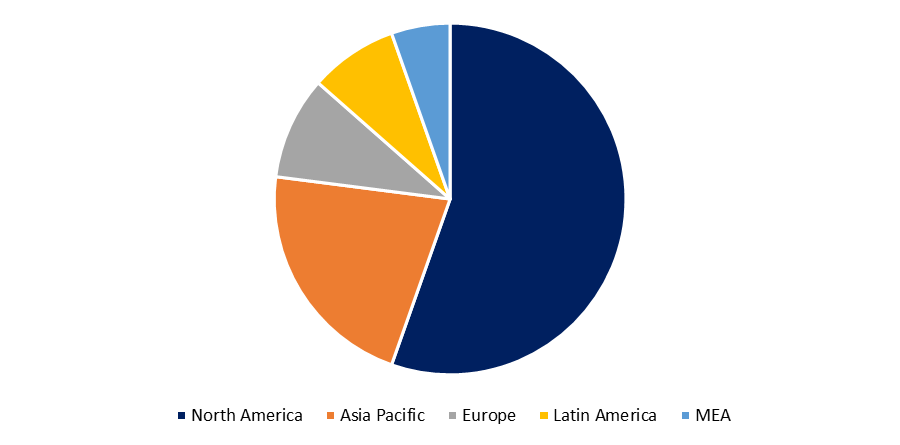Global Anti-Reflective Coatings Market Size, Share & Trends, COVID-19 Impact Analysis Report, By Layer Type (Single Layered, and Multi Layered), By Technology (Vacuum Deposition, Electronic Beam Evaporation, Sputtering, and Others), By Application (Eyewear, Electronics, Solar Panels, Automobile, and Others), and By Region (North America, Europe, Asia-Pacific, Latin America, Middle East, and Africa), Analysis and Forecast 2021 - 2030
Industry: Advanced MaterialsMARKET SUMMARY
Global Anti-Reflective Coatings Market Size, is expected to be worth USD 5.13 Billion in 2021 and is estimated to reach up to USD 9.11 Billion by 2030, at a compound annual growth rate (CAGR) of 8.50% from 2021 to 2030. A growing number of sectors are paying attention to anti-reflective coatings as a result of their expanded applications. In the semiconductor, automotive, building, and aerospace industries, anti-reflective coatings are generally used to shield component surfaces. A cheap technique to reduce glare from computer screens, televisions, flat panels, and other electronic displays is to wear anti-reflective eyewear. Anti-reflective coatings are extremely beneficial when used on high-index lenses, which reflect more light than normal plastic lenses. In general, more light is reflected off the lens surface as the index of refraction of the lens material increases.

Get more details on this report -
COVID-19 ANALYSIS
The worldwide economy has been significantly impacted by COVID-19, which has disrupted international trade and simultaneously impacted households, businesses, financial institutions, industrial facilities, and infrastructure organizations. Due to restrictions on international trade and operational lockdown regulations for the chemical industry, the short-term market demand is anticipated to be constrained. The market has stagnated since the epidemic pounded on the doors of various international markets. Market activity was significantly halted as a result of the government's lockdown, with participants bearing the brunt of the effects in the form of losses, less qualified workers, and a lack of raw materials for production.
MARKET TREND
Growing Need for High Transmitting Lens and Glass Manufacturing Propel Market Growth
The growing demand for high-transmitting lenses and eyewear is expected to increase the use of anti-reflective coatings. The growing eyewear market is advantageous for anti-reflective coatings. This is brought about by an increase in vision impairments and a rise in the number of elderly people, both of which are increasing demand for eyewear. Anti-reflective coatings are projected to become more common due to the increase in demand for eyewear.
MARKET DRIVERS
Focusing on Using Renewable Energy Sources Drive Market Growth
Due to growing demand for a renewable source of electricity, the market for anti-reflective coatings is expected to grow in line with the global installation of solar panels. As the need for energy and the desire to reduce reliance on fossil fuels rise, the market is likely to change. It is normal practice to apply anti-reflective coatings on solar PV panel surfaces. As a result, the market for solar PV is not increasing as quickly as the market for anti-reflective coatings.
MARKET CHALLENGE
Limited Awareness About Benefits of Anti-Reflective Coatings in Eyewear Limit Market Growth
Lack of understanding about the benefits of anti-reflective eyewear is going to get restricted for the growth of the global anti-reflective coatings market. Additionally, the use of uncoated lenses is anticipated to be restricted because they are less expensive than anti-reflective coated lenses. As a result, the anti-reflective coating industry's growth is being restrained. The market for anti-reflective coatings is projected to be constrained by high production costs brought on by costly application processes.
Global Anti-Reflective Coatings Market Report Coverage
| Report Coverage | Details |
|---|---|
| Base Year: | 2021 |
| Market Size in 2021: | USD 5.13 Billion |
| Forecast Period: | 2021-2030 |
| Forecast Period CAGR 2021-2030 : | 8.50% |
| 2030 Value Projection: | USD 9.11 Billion |
| Historical Data for: | 2017-2020 |
| No. of Pages: | 220 |
| Tables, Charts & Figures: | 97 |
| Segments covered: | By Layer Type, By Technology, By Application, By Region, COVID-19 Impact Analysis Report |
| Companies covered:: | Dupont, ZEISS Group, Essilor, Honeywell International Inc, Hoya Corporation, Mitsui Chemicals, Inc., ICOAT COMPANY, LLC, Janos Technology, LLC, VIAVI Solutions Inc., Royal DSM N.V., Optical Coatings Japan, PPG Industries Inc., Rodenstock GmbH |
| Growth Drivers: | 1)The global anti-reflective coatings market is divided into vacuum deposition, electronic beam evaporation, sputtering, and others based on the technology segment. 2)The global anti-reflective coatings market is divided into eyeglasses, electronics, solar panels, automobiles, and others based on the application sector. |
| Pitfalls & Challenges: | COVID-19 has the potential to impact the global market |
Get more details on this report -
MARKET SEGMENTATION
The Global Anti-Reflective Coatings Market is segmented by Layer Type, Technology, Application, and Region. Based on the Layer Type, the market is categorized into Single Layered, Multi Layered. Based on Technology, the market is categorized into Vacuum Deposition, Electronic Beam Evaporation, Sputtering, and Others. Based on Application, the market is categorized into Eyewear, Electronics, Solar Panels, Automobile, and Others. Based on the Region, the market is categorized into North America, Europe, Asia-Pacific, South America, Middle East and Africa.
By Layer Type Insight
The worldwide anti-reflective coatings market is divided into single layered and multi layered segments based on layer type. Due to the narrow range of visible wavelengths covered, the single layered segment has dominated the market share of the global anti-reflective coatings market in 2020. Its dominance is mostly due to its reduced cost as compared to coatings with multiple layers, as well as to its equivalent hardness and endurance.
By Technology Insight
The global anti-reflective coatings market is divided into vacuum deposition, electronic beam evaporation, sputtering, and others based on the technology segment. Due to several processes for depositing layers of the right material onto the optical surface, the vacuum deposition segment has dominated the market share of the global anti-reflective coatings market in 2020. Anti-reflective coatings are typically applied using vacuum deposition technology due to its low environmental impact and versatility. Vacuum deposition has a number of benefits, one of which is the capacity to establish a repeatable and environmentally friendly environment for the process. This is because anti-reflective coating applications are using this technology more frequently. The versatility and requirements of the coating technology are highlighted through vacuum deposition.
By Application Insight
The global anti-reflective coatings market is divided into eyeglasses, electronics, solar panels, automobiles, and others based on the application sector. Due to the rise in presbyopia cases and the demand for progressive lenses, the eyewear segment will have the lion's share of the worldwide anti-reflective coatings market in 2020. Age-related hardening of the crystalline lens of the eye, known as presbyopia, makes reading up close challenging. Reduce glare from computer screens, televisions, flat panel displays, and other electronic displays for a reasonable price by using anti-reflection lenses. Anti-reflective coatings are used to reduce reflection and prevent glare. This makes the display simpler to read and improves visual awareness. A favorable atmosphere for market expansion is created by the availability of a wide variety of marketing conditions.
MARKET SEGMENTATION: BY REGION
The Global Anti-Reflective Coatings Market is categorized into North America, Europe, Asia-Pacific, Latin America, the Middle East and Africa.
North America is anticipated to have the largest market share of the worldwide market for anti-reflective coatings due to the advantageous potential for market expansion in this area has been provided by the expanding demand for anti-reflective coatings in eyewear and their increased use in consumer goods like smartphones, cameras, and flat panel displays. The growth in consumer goods demand is a key factor driving market expansion in this region. The market's growth was aided by the existence of important key players in this area and the demand for anti-reflective coatings from a variety of manufacturing industries. For instance, the US Department of Health and Human Services estimates that approximately 23.9% of Americans over the age of 40 suffer from nearsightedness (about 34 million people).

Get more details on this report -
However, Asia Pacific is anticipated to see the greatest growth rate throughout the projected period of the global anti-reflective coatings market due to the growing need for packaging in logistics, the growing aerospace manufacturing industry, and other Chinese manufacturing processes. The fastest-growing segments of the electronics market were smartphones, televisions, wires, cables, portable computing devices, gaming systems, and other personal electronic devices. The nation produces enough electronics to meet domestic demand while also exporting its surplus to other nations. Due to all of the aforementioned factors, China is most likely to dominate the Asia Pacific market.
COMPETETIVE ANALYSIS
- Dupont
- ZEISS Group
- Essilor
- Honeywell International Inc
- Hoya Corporation
- Mitsui Chemicals, Inc.
- ICOAT COMPANY, LLC
- Janos Technology, LLC
- VIAVI Solutions Inc.
- Royal DSM N.V.
- Optical Coatings Japan
- PPG Industries Inc.
- Rodenstock GmbH
- Others
RECENT DEVELOPMENT
- In October 2020, Mitsui Chemicals purchased COTEC GmbH to broaden the scope of its division for vision care materials.
- In May 2020, TechShield® Anti-Reflective Coatings, anti-reflective lens coatings with ISO-certified technology for ophthalmic lenses, were introduced by VSP Optics.
REPORT OVERVIEW
The scope of the report includes a detailed study of regional markets for Global Anti-Reflective Coatings Market. The Global Anti-Reflective Coatings Market is segmented by Layer Type, Technology, Application, and Region. It reveals the market situation and future forecast. The study also covers the significant data presented with the help of graphs and tables. The report covers information regarding the competitive outlook including the market share and company profiles of the key participants operating in the global anti-reflective coatings market.
SEGMENTATION
By Layer Type
- Single Layered
- Multi Layered
By Technology
- Vacuum Deposition
- Electronic Beam Evaporation
- Sputtering
- Others
By Application
- Eyewear
- Electronics
- Solar Panels
- Automobile
- Others
By Region
- North America- U.S., Mexico, Canada
- Europe- UK, France, Germany, Italy, Spain, Rest of Europe
- Asia-Pacific- China, Japan, India, South Korea, Rest of Asia Pacific
- South America- Brazil, Argentina, Colombia, Rest of South America
- The Middle East and Africa- GCC, South Africa, Rest of Middle East & Africa
Need help to buy this report?